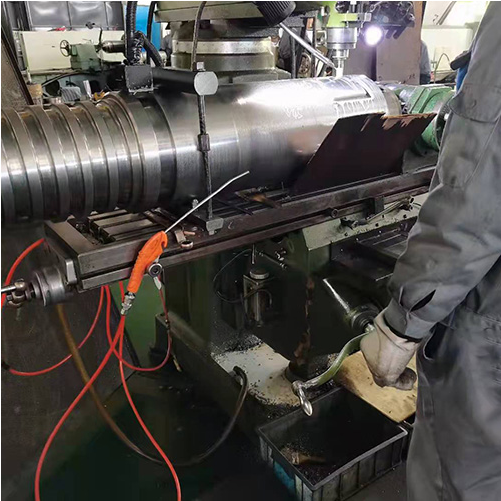

current position:Information and data>What is Plasma Spraying
Plasma spraying uses a certain heat source to heat and melt the coating material, and atomize it into extremely fine particles with a high-speed airflow. And spray on the surface of the workpiece at a high speed to form a coating.

Thermal spray alloy powders include nickel-based, iron-based and cobalt-based alloy powders, which are used in the repair and protection of mechanical parts according to the hardness of the coating. It can make mechanical parts obtain one or more properties, such as wear resistance, corrosion resistance, oxidation resistance, heat resistance, etc.
Features of plasma spraying technology:
1. The base material is not limited, it can be metal or non-metal, and can be sprayed on various base materials;
2. The spraying materials are very wide, and the thermal spraying technology can spray almost all solid engineering materials such as cemented carbide, ceramics, metals, graphite, etc.;
3. The temperature of the base material is very low during the spraying process, and there is no stress and deformation.
4. Flexible and convenient operation process, not limited by the shape of the workpiece;
Principle of thermal spraying
The so-called thermal spraying is to use specific heat sources such as electric arcs, plasma arcs, combustion flames, etc. to heat powder or filamentary metal and non-metallic coating materials into a molten or semi-molten state. The technology of forming a surface covering layer with various functions by the force of the flame flow itself or the atomization of additional high-speed air flow and spraying it on the surface of the pretreated base material at a certain speed.
The coating material can be powder, ribbon, wire or rod.
Thermal spray guns provide the necessary heat from gas, electric or plasma arcs. The thermal spray material is heated to a plastic or molten state and then accelerated by compressed air, causing a beam of bound particles to hit the surface of the substrate.
The particles hitting the surface are deformed by punching to form a laminate that adheres to the prepared substrate surface, then cool and accumulate to form a layered coating.
Due to the different coating materials, it can achieve high temperature corrosion resistance, wear resistance, heat insulation, anti-electromagnetic wave and other functions.
The classification of thermal spraying should be based on the form of heat source. On this basis, it can be re-sprayed in the form of spraying materials, material properties, energy levels, and spraying environment.
Thermal spraying can be simply divided into four categories: flame spraying, arc spraying, plasma spraying and special spraying.
Thermal spray equipment and technology
Although the methods of thermal spraying vary, according to the principle of thermal spraying technology, the equipment is mainly composed of spray gun, heat source, coating material supply device, control system and cooling system.
The thermal spraying process is: workpiece surface pretreatment → workpiece preheating → spraying → coating post-treatment
1) Surface pretreatment
In order for the coating to bond well with the substrate material, the substrate surface must be clean and rough, and there are many ways to decontaminate and roughen the surface. The choice of method depends on the design requirements of the coating and factors such as the material, shape, thickness of the substrate, original surface conditions and application conditions. The purpose of the decontamination treatment is to remove all dirt on the surface of the workpiece, such as oxidized skin, oil stains, paint and other dirt. The key is to remove the surface of the workpiece and penetrate the grease in it.
2) Preheat
The purpose of preheating is to remove moisture and moisture from the surface of the workpiece and to increase the interface temperature when the spray particles come into contact with the workpiece. In order to improve the bonding strength of the coating and the substrate, reduce the stress caused by the difference between the substrate and the coating material, which leads to the cracking of the coating.
3) Spray
Which spraying method is used for spraying mainly depends on the selection of spraying materials, the working conditions of the workpiece and the requirements for coating quality.
4) Post-coating treatment
The coating obtained by spraying cannot be used directly, and a series of post-treatments must be carried out.
5. The coating thickness is between 0.01 and several millimeters;
6. The properties of the coating are different, and it can form a coating with various special functions such as wear resistance, corrosion resistance, insulation, oxidation resistance, insulation, conductivity, radiation protection and so on.
7. Strong adaptability and good economic benefits.
Hot information

